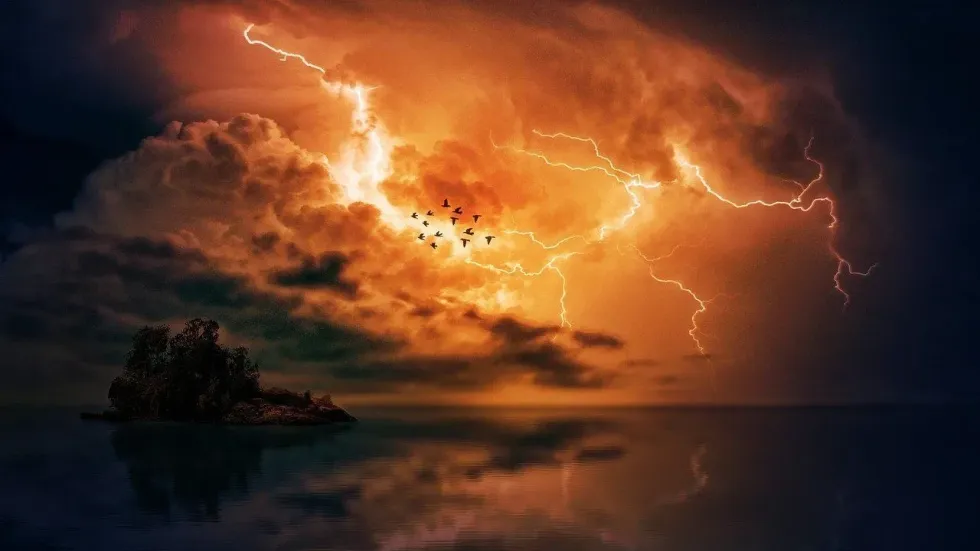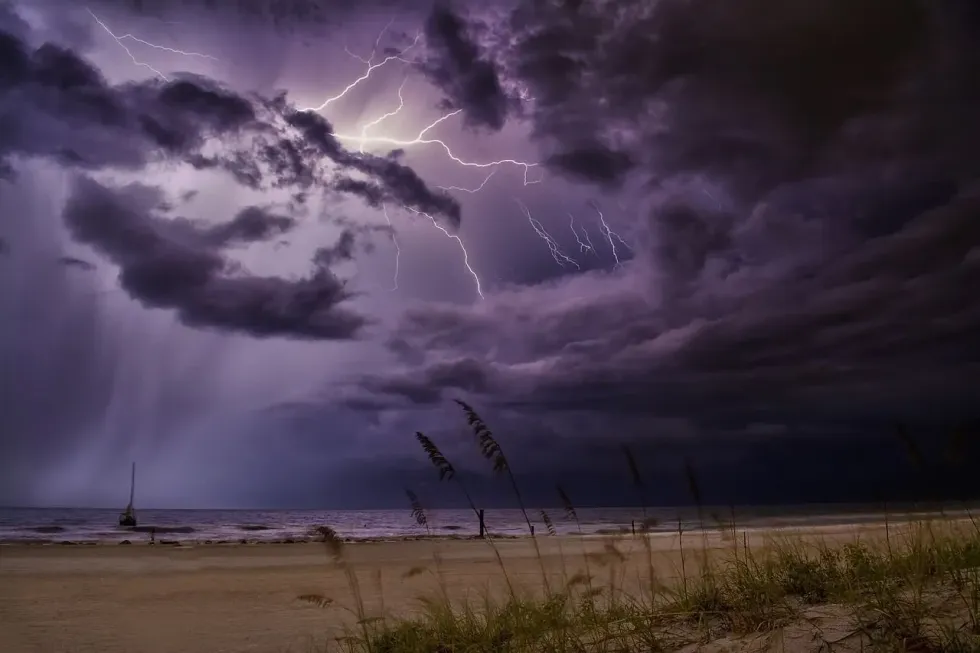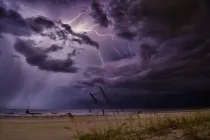Here Are Some Facts About Famous Thunderstorms That Might Shock You

Thunderstorms are a dangerous phenomenon.
Whether it is a mild thunderstorm or a severe thunderstorm, there is always some sort of damage to life and property. Thunderstorms are often accompanied by rain and lightning.
Thunderstorms can cause damage to buildings and the lives of people can be lost, all in one night. Thunderstorms are mostly short-lived but have huge consequences especially when it is accompanied not only by rains and lightning but also heavy clouds, hail, and strong wind.
A thunderstorm is caused when warm air rises up in the sky and the moisture which forms in the clouds begins to precipitate.
As the cool air travels down, electrical charges are formed within the clouds above. When these electrical charges become large, lightning occurs.
When lightning crosses these groups of clouds, a loud sound can be heard. If this is accompanied by the strong swirling wind, a tornado is formed, otherwise, it is a thunderstorm. Now the intensity of the lightning and the current of the wind determine whether it will pour a light thunder-shower or lead to a massive thunderstorm.
These thunderstorms may occur in any region of the world, although the likelihood of their occurrence is much lower in the polar regions. All the cities located in the temperate and tropical regions of the world are always at a higher risk of experiencing thunderstorms.
In the United States, Florida, New Mexico, the Gulf Coast, and a few others are among those most frequently hit by a thunderstorm, mostly because of the temperature and climate changes in these regions.
Hurricanes brought about with a thunderstorm can cause floods as they can push more than 19.7 ft (6 m) of water ashore, sometimes, even more, depending on the wind and the amount of instability in the atmosphere of that city. The aftermath of such storms is also threatening.
Florida reported that after a hurricane hit it, roughly 900 pythons escaped onto the streets, further increasing the danger to lives.
Advance warnings also do little help, especially in the case of an impending tornado. This is because sometimes, tornadoes may move from their place of formation to other directions, faster than the formula race cars move on their tracks.
If you love learning about different types of weather and extreme weather conditions then you will love this article! Keep reading to know more about different weather phenomena like rain, severe thunderstorms, forest fires, and others. Which thunderstorm facts will you discover?
Severe Effects Of Thunderstorms
Whilst they are interesting to learn about, thunderstorms can actually have serious impacts. There are several effects that thunderstorms have on the surface of the world. The most devastating of them is the destruction of life and property such as buildings, cars, and other vehicles, belongings, sense of ownership, and so on.
- In worst cases, there can be a loss of life due to a thunderstorm. People who get away with their lives feel the loss of their loved ones. Such individuals may feel lost and may develop Post Traumatic Stress Disorder (PTSD) because of what has happened to them or their experience.
- Thunderstorms sometimes turn into flash floods, causing more pain and distress. Lightning can also cause fires.
- There have been instances where lightning has hit pine forests and chemical industries, causing large-scale fires to spread across the city. Such sudden fires are difficult to contain and people are mostly unaware of how to get away from such disasters with their lives and belongings intact.
- If the thunderstorm turns into a hail storm, the destruction increases multifold. Hail the size of a small snowball can cause extreme damage to cars and other vehicles. It can also kill animals and livestock because of the speed with which it hits.
- During tornadoes, cars, people, livestock are all in danger of being pulled up by the wind. The winds are so strong that trees get uprooted and electric poles get pulled towards the eye of the storm.
- Thunderstorms can be unpredictable and devastating beyond the calculations made by scientists and researchers. The effects of a storm can be devastating leading to lives being lost, crops being destroyed, severe damage to the roofs of houses, damage to vehicles, and raging shores can cause floods in coastal areas.
- A flash flood with severe thunderstorms or the formation of a tornado alley with heavy rain and hurricanes along the shores are difficult to predict by the scientists even if they have previously recorded data of such storms.
- Thousands are affected in the city and even across the country as the storms devour everything in their way.
- Scientists have formed the Doppler Radar to help detect the changes in wind pressure and flow to help them make more accurate predictions about the weather with the aim to help save lives. It is also believed that animals like cats and dogs understand when a thunderstorm is impending in the region.
- People have also observed earthworms wiggling their way out of the ground when some major thunderstorm is about to occur.
- These animals have a natural feeling attached within them which enables them to feel if something damaging is going to take place, especially something in the natural environment.
- After all, they are a part of the natural ecosystem and unlike humans, they have stayed connected to the forces of nature more closely, while humans have drifted away from nature, towards technology.
Formation Of Thunderstorms
The most common antecedent of a thunderstorm is the moving of wind, that is the ascending of hot air and the descending of cold wind. If this vertical motion of air becomes unstable, it gives rise to perfect conditions for the formation of a thunderstorm.
- The instability takes place when the cold air travels down and incidentally lies above the hot air. As the amount of hot air under the cold air increases, the energy released pushes both hot and cold air upwards, causing instability.
- Furthermore, if the hot air rising up carries moisture with it, clouds begin to form as soon as the hot air reaches high enough. Which means convention is the cause of a thunderstorm.
- As the air starts to convert into water droplets, latent heat energy is released. This further increases the instability. If this pattern continues in the same region multiple times, cells are created. As multiple such cells are created in and around the same region, they merge and lead to precipitation, which eventually adds lightning and thunder to form the ultimate mix.
- The clouds, however, start as small individual clouds which later merge to cause torrential rains and bring in the storm.
- There are three basic stages of a thunderstorm that enable experts to understand whether the storm is about to advance or dissipate into thin air.
- This is the developing stage, when the rains start and the winds are not very strong, slowly, the clouds come together as one and the cells of strong winds combine together. This is followed by the second stage, the mature stage, which occurs when the clouds and the cells have combined and there is an increase in rainfall.
- It is in this stage that hail, lightning, swirling winds form tornadoes, and maximum destruction of life and property takes place.
- Eventually, as the rains continue, the air regains stability and the dissipating stage begins. Although at this stage the rains decrease and the wind is dispersed, lightning can still occur for a few more hours.
- On average, a thunderstorm is formed after around 13.2 million gal (60 million L) of water vapor reaches the sky and consensus to form clouds that are ready to burst.
- As mentioned earlier, there are three conditions absolutely necessary for the building up of a thunderstorm. These are moisture, a lift mechanism, and unstable rising air. If any of these ingredients or components are missing, thunderstorms will not occur, at least not a severe one.
- Although thunderstorms may occur anytime, anywhere, the news suggests that they are more common during the spring and summer seasons, probably because of greater levels of moisture during these months.
- Interestingly, since thunderstorms are caused entirely by natural processes, such storms have also been observed on planets other than our Earth, such as Jupiter, Neptune, Saturn, and Venus.
Types Of Storms
Earlier, thunderstorms used to be classified into types depending on their origin, such as local, frontal, or orographic (mountain-initiated). The mountain-initiated storms occurred when the water vapor that went up to form clouds was created with melting snow.
- The heat of the Sun falls directly on the top of the mountains, even before it reaches the plains, which is why it is common for the mountains to heat up and contribute to the building of major storms in nearby areas.
- This meant that all areas around and near the mountains were always at risk, especially during the summer and spring seasons as during winters, the snowfall ensured that lesser amounts of ice or snow would melt because of the Sun. However, over the years it was found that it is easier to group the types of thunderstorms in accordance with their characteristics and formations.
- According to the US reports, any thunderstorm which causes hails of size 1 in (2.5 cm) diameter or/and tornadoes with the wind moving at a speed of more than or equal to 58.1 mph (93.5 kph), will be regarded as severe.
- Most reports suggest that there are four main types into which storms can be classified. These include single-cell thunderstorms, multi-cell thunderstorms, the Squall line thunderstorm, and the Supercell thunderstorm.
- A single-cell storm usually is short-lived with a brief period of rain and hail. The intensity depends purely on the amount of instability created in the atmosphere of that region. They mostly take place during summer and spring.
- As these single-cell storms combine together, they give rise to multi-cell storms. As the strong winds and rain combine in the area, the risk of flash floods increases immensely.
- As the temperatures fluctuate, people can hear the roaring sounds of lightning, accompanied sometimes by hailstones.
- The next type of thunderstorm is the squall line thunderstorm. This thunderstorm covers a larger area of more than hundreds of miles with wind speeds of no less than 70 mph (112.6 kph). They can be accompanied by hailstones, a tornado, or even more dangerous, straight-line strong winds.
- As the name suggests, supercell thunderstorms are the mother of all thunderstorms. The upper draft of this storm keeps rotating which ensures that the storm will not dissipate soon and starts to function in an organized way.
- The storm looks sort of like a hook in the sky. Very commonly, this leads to the formation of a tornado. Many others may also accompany it as the supercell storm continues to rage. There can be a burst of severe hailstones or even flash floods.

How fast do clouds form?
There are several thousand storms that occur around the world every single day. In the US itself, there are about 100,000 storms that cause destruction each year. The assessment of weather and the formation of clouds tell us a lot about the progress of the storm.
- However, nature still has a way of surprising us and changing the weather before humans can even understand what is happening. It is due to these sudden changes in weather that so many are killed and evacuations are not successful in most cases.
- Once the moisture starts to rise and instability is created in the atmosphere, a thunderstorm can start within 15-20 minutes. This does not give much time for the people to get prepared for what is about to come.
- Although scientists are able to monitor the wind patterns and predict the possibility of a storm, they cannot accurately predict its intensity as the storm can become intense within seconds of its formation. How fast a single-cell storm can become a multi-cell storm depends largely on the speed and strength of the wind.
- It is because of the continuous flow of wind that these clouds come together and merge eventually leading to a more destructive storm. The thunderstorm can become severe and very costly to manage if the speed measured and the size of the head are not determined soon.
- As the number of people killed and destruction that occurred is recorded for future predictions, lives lost are greatly mourned and regretted. Such storms can easily destroy entire cities including their infrastructure and population, leaving nothing but wreckage as it dissipates into thin air.
Did You Know...
The most dangerous and damaging thunderstorm in the recorded history of humankind was the storm of Iowa in August (2020). The Derecho storm is recorded to be the most costly thunderstorm in the US to date according to the national oceanic records.
- The US had to spend more on this storm than the hurricanes that occurred 10 times before Iowa.
- According to the National Oceanic and Atmospheric Administration, it traveled 770 mi (1,239 km) from South Dakota through Ohio, destroying a number of cars and other vehicles, cops, and buildings in its way along with the lives of numerous men and women.
- It is believed that the biggest and most dangerous storm in the world occurred in India, back in 2014, when the voltage was recorded to be 1.3 billion volts.
- An entire electric field was created by this thunderstorm as it came to be called on the news as the storm of the century. Scientists and researchers suggest that the storm could have created a power level nearly equivalent to the terrestrial gamma-ray flash.
- It has been confirmed and also reported on the news that the worst-hit storms have occurred in Africa and the Asia-Pacific region.
- The Great Bhola Cyclone in Bangladesh (1970) is regarded as the deadliest storm claiming between 300,000-500,000 lives. Bangladesh also experienced a deadly tornado in 1989, leaving people homeless. The great thunderstorms affected everything on the ground.
- In 1913, the Greatest snowstorm in history hit Eastern Colorado city and its people suffered greatly.
- The storm hit the city from the East and crippled it in the month of April. Eastern Colorado had greater than average snowfall from September onwards but towards April the regular snowfall turned into a storm and wreaked havoc over the city.
- Readers suggest that all these deadly storms along with the many others that have taken place across the world in Mexico, India, the US, the head of the Gulf region, north mountains, east country regions have left people shaken.
- The great thunderstorm, formation of tornado alley, gusty winds, and the changing weather have killed millions and millions of people throughout the years.
- Irrespective of whether it is night or day, summer or winter, north, south, east or west, these thunderstorms have killed many individuals of all age groups.
- The future depends on accurate records and numbers taken from the sites of hurricanes, tornadoes, and other storms.
- The aftermath of evening storms is even more horrific as people may be sleeping when the storms hit, claiming more lives than the afternoon storms.
- The greatest storm is believed to be the Widecombe-in-the-Moor in Dartmoor, England (1638) wherein an entire church was struck by a big ball of lightning, destroying it and the area nearby within seconds of impact.
- These are among the most famous thunderstorms seen around the world. It is believed that the thunderstorm that took place in Texas (1995), caused the most damage as the hailstones were as big, maybe even bigger than the common cricket ball.
We Want Your Photos!
More for You
See All
Bachelors in Business Administration

Aashita DhingraBachelors in Business Administration
Based in Lucknow, India, Aashita is a skilled content creator with experience crafting study guides for high school-aged kids. Her education includes a degree in Business Administration from St. Mary's Convent Inter College, which she leverages to bring a unique perspective to her work. Aashita's passion for writing and education is evident in her ability to craft engaging content.
Disclaimer
1) Kidadl is independent and to make our service free to you the reader we are supported by advertising. We hope you love our recommendations for products and services! What we suggest is selected independently by the Kidadl team. If you purchase using the Buy Now button we may earn a small commission. This does not influence our choices. Prices are correct and items are available at the time the article was published but we cannot guarantee that on the time of reading. Please note that Kidadl is a participant in the Amazon Services LLC Associates Program, an affiliate advertising program designed to provide a means for sites to earn advertising fees by advertising and linking to Amazon. We also link to other websites, but are not responsible for their content.
2) At Kidadl, we strive to recommend the very best activities and events. We will always aim to give you accurate information at the date of publication - however, information does change, so it’s important you do your own research, double-check and make the decision that is right for your family. We recognise that not all activities and ideas are appropriate for all children and families or in all circumstances. Our recommended activities are based on age but these are a guide. We recommend that these ideas are used as inspiration, that ideas are undertaken with appropriate adult supervision, and that each adult uses their own discretion and knowledge of their children to consider the safety and suitability. Kidadl cannot accept liability for the execution of these ideas, and parental supervision is advised at all times, as safety is paramount. Anyone using the information provided by Kidadl does so at their own risk and we can not accept liability if things go wrong.
3) Because we are an educational resource, we have quotes and facts about a range of historical and modern figures. We do not endorse the actions of or rhetoric of all the people included in these collections, but we think they are important for growing minds to learn about under the guidance of parents or guardians.







